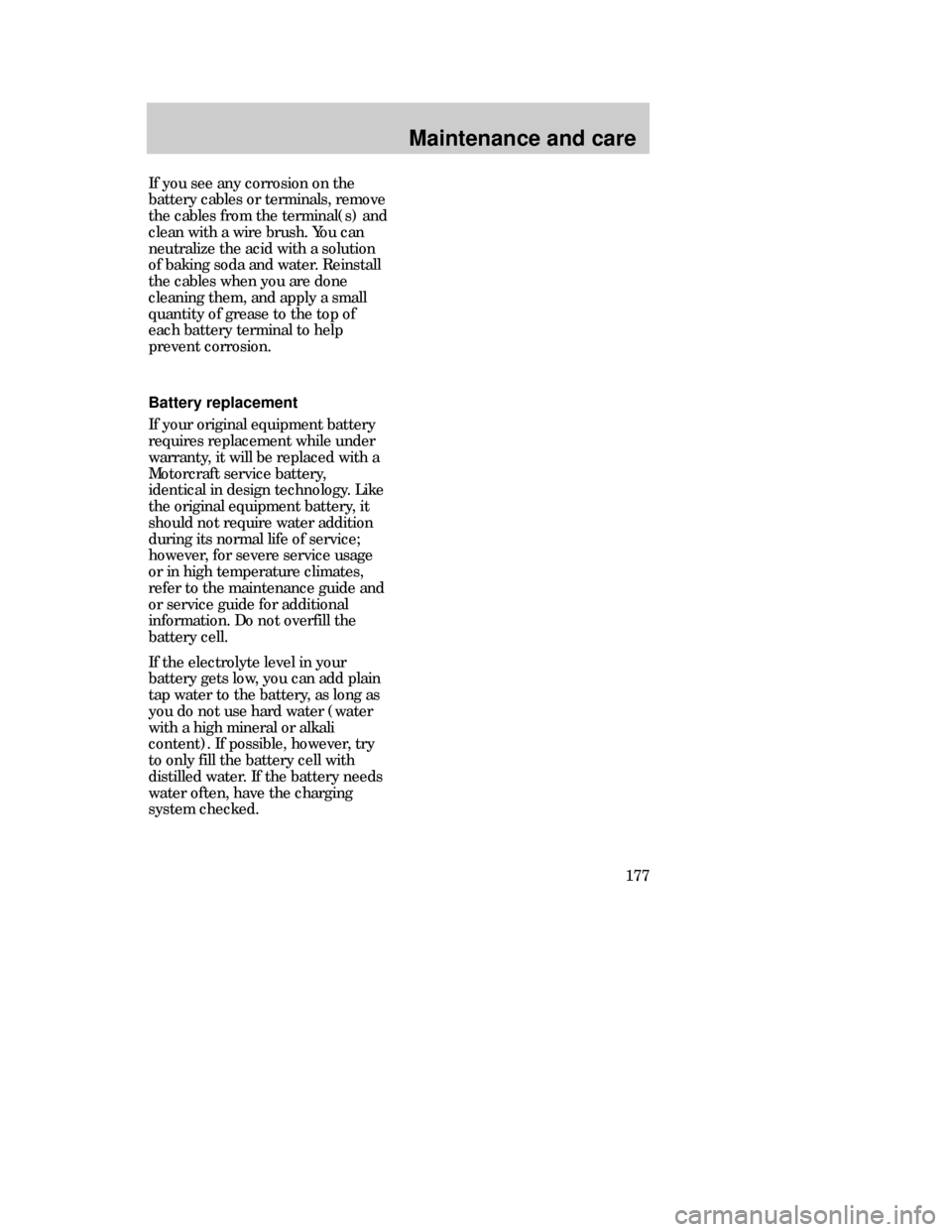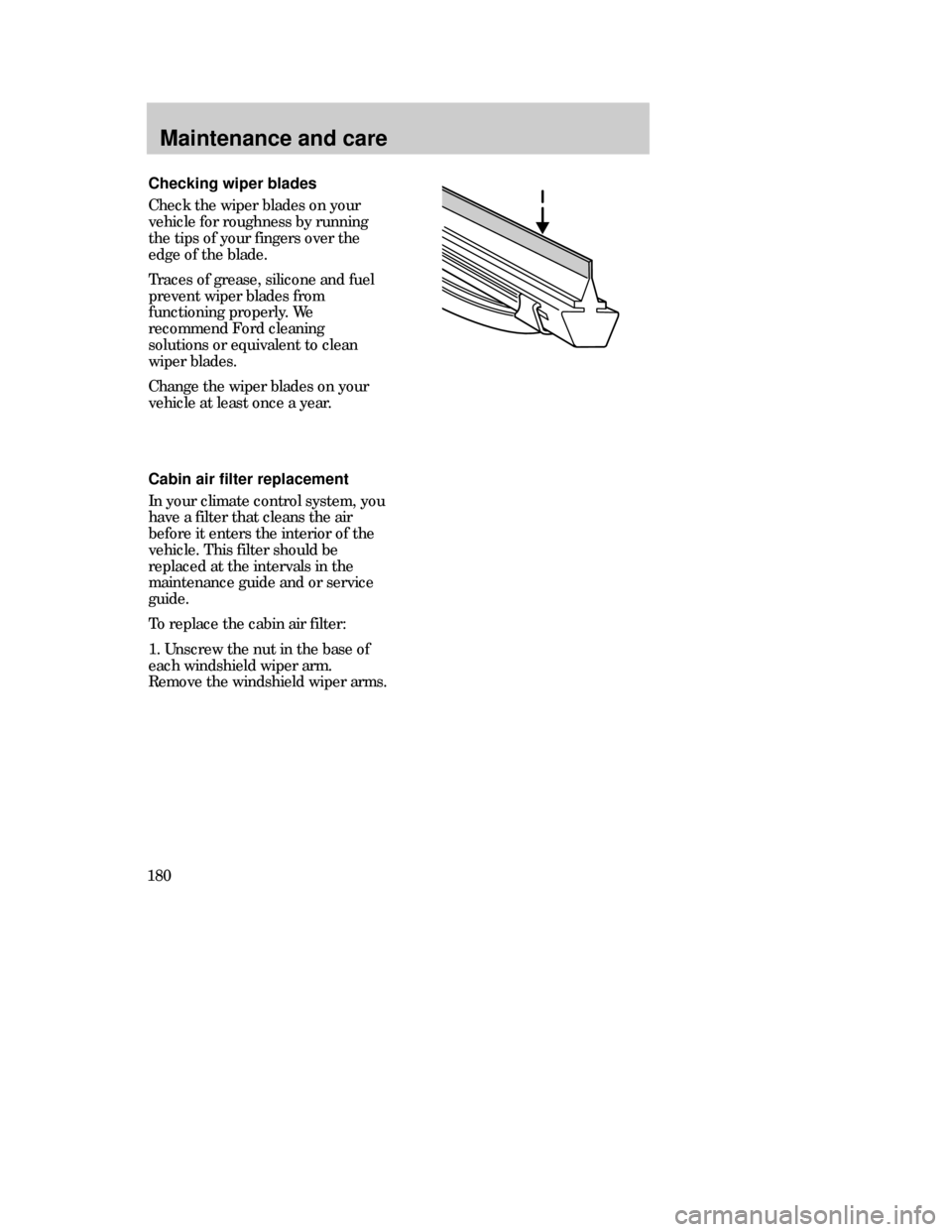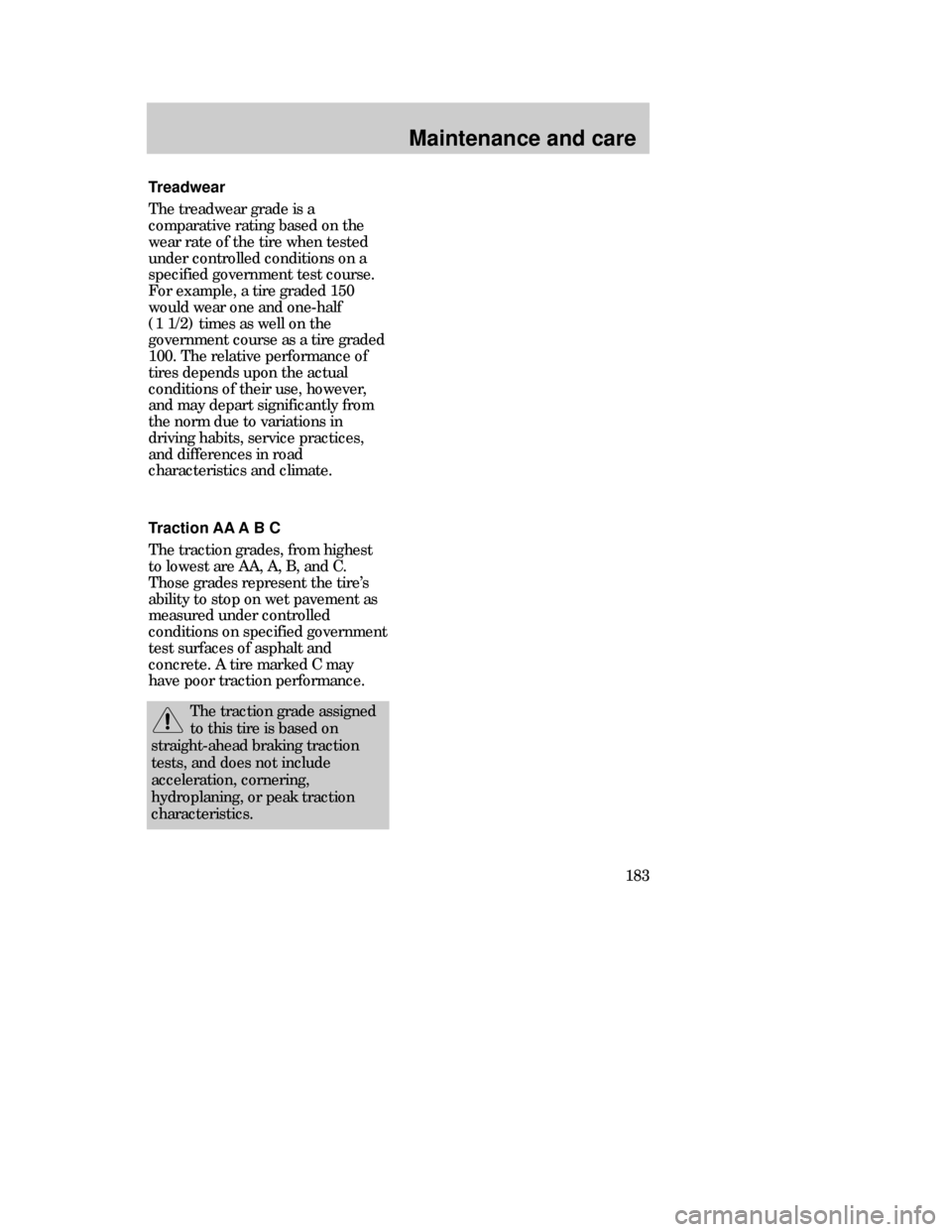service Mercury Mystique 1999 s Owner's Guide
[x] Cancel search | Manufacturer: MERCURY, Model Year: 1999, Model line: Mystique, Model: Mercury Mystique 1999Pages: 244, PDF Size: 2.15 MB
Page 167 of 244

Maintenance and care
167
Empty and used oil
containers must be disposed
of at an authorized waste disposal
facility.
Engine oil filler cap
The design of the filler cap varies
by engine. To open, turn in the
direction of the arrow and pull. Do
not open the cap while the engine
is running.
Refer to the maintenance guide
and or service guide for additional
information.
Always dispose of used
automotive fluids in a
responsible manner. Follow your
communityÕs standards for
disposing of these types of fluids.
Call your local recycling center to
find out more about recycling
automotive fluids.
It is recommended you use the
appropriate Motorcraft oil filter (or
another brand meeting Ford
specifications) for your engine
application.
31MMCen 4/13/99 2:17 PM Page 167
Page 172 of 244

Maintenance and care
172
MAX
MIN
Adding engine coolant
1. Before removing the engine
coolant recovery cap, turn the
engine off and allow it to cool.
2. When the engine is cool, turn
and remove the cap.
¥ Step back for a moment while
the pressure in the reservoir is
released.
¥ Stand away from the reservoir
opening. Hot steam or coolant
spray may be released.
3. Add engine coolant until the
fluid level in the reservoir is
between the MAX and MIN lines on
the reservoir.
Follow the recommended service
interval for changing engine
coolant as outlined in the
maintenance guide and or service
guide. Refer to
Capacities and
specifications
for more
information on engine coolant
specifications.
Have your dealer or a qualified
service technician check the engine
coolant system for leaks if you have
to add more than a litre (quart) of
engine coolant per month.
Never remove the coolant
recovery cap while the
engine is running or hot.
31MMCen 4/13/99 2:17 PM Page 172
Page 174 of 244

Maintenance and care
174
Automatic transaxle fluid
Follow the scheduled service
intervals outlined in the
maintenance guide and or service
guide.
Before adding any fluid, make sure
the correct type is used. The type
of fluid used is normally indicated
on the dipstick and/or dipstick
handle and also in the
Lubricant
specifications
section in the
Capacities and specifications
chapter.
Do not drive the vehicle if the fluid
level is below the hole at the
bottom of the dipstick and outside
temperatures are above 10¡C
(50¡F).
Your transaxle does not use up
fluid. However, it is recommended
that you check the transaxle fluid
at least twice a year. The fluid level
should be checked if the transaxle
is not working properly, i.e., if the
transaxle slips or shifts slowly or if
you notice some sign of fluid
leakage.
Transaxle fluid should be checked
at normal operating temperatures
of 66¡C - 77¡C (150¡F - 170¡F) on a
level surface while the engine is
running in the P (Park) gearshift
lever position. The normal
operating temperature can be
reached after approximately 32 km
(20 miles) of driving.
31MMCen 4/13/99 2:17 PM Page 174
Page 176 of 244

Maintenance and care
176
Battery
Your vehicle may be equipped with
a Motorcraft maintenance-free
battery. The Motorcraft
maintenance-free battery normally
does not require additional water
during its life of service. However,
for severe service usage or in high
temperature climates, refer to the
maintenance guide and or service
guide for additional information.
Keep the electrolyte in each cell up
to the ÒlevelÓ indicator. Do not
overfill the battery cell.
For longer, trouble-free operation,
keep the top of the battery clean
and dry. Also, make certain the
battery cables are always tightly
fastened to the battery terminals.
6. Remove the dipstick and inspect
the fluid level. The fluid level
should be in the crosshatched area
on the dipstick.
7. If necessary, add fluid in .25 litre
(1/2 pint) increments through the
filler tube until the level is correct.
8. If an overfill occurs, excess fluid
should be removed by a qualified
technician.
An overfill condition of transaxle
fluid may cause shift and/or
engagement concerns and/or
possible damage.
31MMCen 4/13/99 2:17 PM Page 176
Page 177 of 244

Maintenance and care
177
Battery replacement
If your original equipment battery
requires replacement while under
warranty, it will be replaced with a
Motorcraft service battery,
identical in design technology. Like
the original equipment battery, it
should not require water addition
during its normal life of service;
however, for severe service usage
or in high temperature climates,
refer to the maintenance guide and
or service guide for additional
information. Do not overfill the
battery cell.
If the electrolyte level in your
battery gets low, you can add plain
tap water to the battery, as long as
you do not use hard water (water
with a high mineral or alkali
content). If possible, however, try
to only fill the battery cell with
distilled water. If the battery needs
water often, have the charging
system checked.
If you see any corrosion on the
battery cables or terminals, remove
the cables from the terminal(s) and
clean with a wire brush. You can
neutralize the acid with a solution
of baking soda and water. Reinstall
the cables when you are done
cleaning them, and apply a small
quantity of grease to the top of
each battery terminal to help
prevent corrosion.
31MMCen 4/13/99 2:17 PM Page 177
Page 180 of 244

Maintenance and care
180
Checking wiper blades
Check the wiper blades on your
vehicle for roughness by running
the tips of your fingers over the
edge of the blade.
Traces of grease, silicone and fuel
prevent wiper blades from
functioning properly. We
recommend Ford cleaning
solutions or equivalent to clean
wiper blades.
Change the wiper blades on your
vehicle at least once a year.
Cabin air filter replacement
In your climate control system, you
have a filter that cleans the air
before it enters the interior of the
vehicle. This filter should be
replaced at the intervals in the
maintenance guide and or service
guide.
To replace the cabin air filter:
1. Unscrew the nut in the base of
each windshield wiper arm.
Remove the windshield wiper arms.
31MMCen 4/13/99 2:17 PM Page 180
Page 183 of 244

Maintenance and care
183
Treadwear
The treadwear grade is a
comparative rating based on the
wear rate of the tire when tested
under controlled conditions on a
specified government test course.
For example, a tire graded 150
would wear one and one-half
(1 1/2) times as well on the
government course as a tire graded
100. The relative performance of
tires depends upon the actual
conditions of their use, however,
and may depart significantly from
the norm due to variations in
driving habits, service practices,
and differences in road
characteristics and climate.
Traction AA A B C
The traction grades, from highest
to lowest are AA, A, B, and C.
Those grades represent the tireÕs
ability to stop on wet pavement as
measured under controlled
conditions on specified government
test surfaces of asphalt and
concrete. A tire marked C may
have poor traction performance.
The traction grade assigned
to this tire is based on
straight-ahead braking traction
tests, and does not include
acceleration, cornering,
hydroplaning, or peak traction
characteristics.
31MMCen 4/13/99 2:17 PM Page 183
Page 185 of 244

Maintenance and care
185
Checking tire pressure
Check the tire pressure
periodically after the vehicle has
been parked for at least one hour
or has been driven less than 5 km
(3 miles). Inflate the tires as
necessary. To check the tire
pressure, insert the tire pressure
gauge into the valve.
The cold pressure amount is listed
on the Safety Compliance
Certification label.
Improperly inflated tires can
affect vehicle handling and
can fail suddenly, possibly
resulting in loss of vehicle control.
Rotating tires
Rotate your tires at regular
intervals for even wear. Rotation
intervals are listed in the
maintenance guide and or service
guide.
31MMCen 4/13/99 2:17 PM Page 185
Page 187 of 244

Maintenance and care
187 Dispose of worn tires in
accordance with local
environmental regulations.
Refer to the Safety Compliance
Certification label to determine the
specific size tire and wheel Ford
Motor Company recommends for
use on this vehicle.
When purchasing replacement tires
for your vehicle, consult your
dealer or a qualified service
technician to ensure that the
correct tire type is used.
31MMCen 4/13/99 2:17 PM Page 187
Page 188 of 244

Maintenance and care
188
The tires on your vehicle have all-
weather treads to provide traction
in rain and snow. However, in some
climates, using snow tires and
chains may be necessary. Ford
offers snow chains as a Ford
approved accessory and
recommends use of these or their
equivalents on approved tires. See
your dealer or a qualified service
technician for more information on
tire chains for your vehicle. Follow
these guidelines when using snow
tires and chains:
¥ Install chains securely, verifying
that the chains do not touch any
wiring, brake lines or fuel lines.
¥ Install the chains on the front
tires only.
¥ Do not use tire chains on 205/60
tires and 205/55R16 Z rated tires.
Steering, suspension and body
components may be damaged by
use of chains.
Snow tires must be the same
size and grade as the tires
you currently have on your
vehicle.
Using snow tires and chains
31MMCen 4/13/99 2:17 PM Page 188